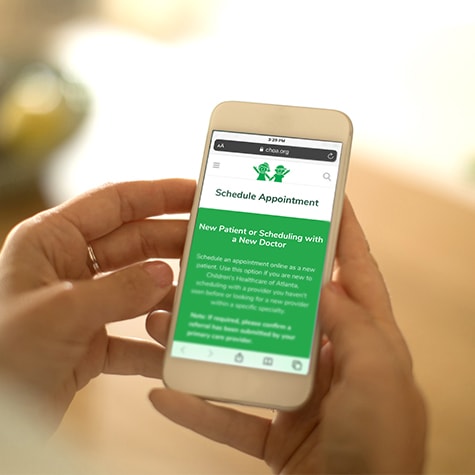Advanced Spine Surgery Uses Tension to Correct a Patient’s Scoliosis
What is vertebral body tethering, and which patients are candidates?
Vertebral body tethering, also known as VBT or spinal tethering, is an innovative procedure and minimally invasive approach to scoliosis surgery in children with growth remaining.
“Vertebral body tethering isn’t here to replace posterior spinal fusion, because that’s the gold standard for scoliosis surgery,” says Joshua Murphy, MD, a Pediatric Orthopedic and Spine Surgeon at Children’s Healthcare of Atlanta. “VBT can be an additional option for patients in lieu of a spinal fusion, depending on the patient’s spinal deformity and growth remaining.”
About 2-3% of children in the U.S. have or will be diagnosed with scoliosis, but most will not have harmful long-term effects. However, some kids can develop problems later in life if not treated, including chronic back pain and heart and lung problems. Children should be screened between the ages of 9 and 16 by their pediatrician or during a scoliosis screening offered at Georgia public middle schools. If a child’s spinal curvature is diagnosed and continues to progress past 45 degrees and the patient still has substantial growth remaining, a procedure like VBT can be beneficial.
How is VBT different from other spine surgeries?
Spinal tethering takes about three to four hours and requires a two- to three-day hospital stay, the same as a spinal fusion. The VBT technique uses a series of screws and a fiber tether that are implanted into each vertebral body, or vertebra, and is performed either thoracoscopically, or in a minimally invasive way, through four to five small incisions in the chest or through small incisions in what is known as a mini open procedure.
“A polyethylene tape is fed through the anchors and tightened to create tension between each anchor. Approximately 50% or more of the spinal deformity may be corrected during surgery, and the remaining correction is obtained as a child continues to grow,” Dr. Murphy explains. “We are using a child’s growth to correct the spinal curve.”
The procedure is ideal for patients who have been diagnosed with idiopathic scoliosis and have a curve between 45 and 60 degrees with adequate growth remaining. Translational studies and, more recently, clinical studies, suggest that approximately 50% of the patient’s spinal motion is retained after a VBT surgery. Children are able to return to activities at approximately six weeks after VBT surgery versus three months after a spinal fusion.
Ideally, the surgery is timed with the patient’s growth and requires only one surgery in the patient’s lifetime; however, doctors are still learning about the long-term effects of this innovative procedure as every patient’s growth is different. Currently, it appears about 20-30% of patients will achieve complete correction of the curve, 40-60% will achieve partial correction to less than 30 degrees, about 20-25% of patients will require an eventual posterior spinal fusion and about 10% of patients will “over correct.” That’s why rigorous monitoring of patients who undergo innovative procedures like VBT is important.

How is Children’s approaching new spine surgery techniques like VBT?
Dr. Murphy is one of only a few orthopedic surgeons in Georgia who has performed the surgery on kids. He performed the first VBT on a pediatric patient in Georgia at Children’s in 2019, shortly before the U.S. Food and Drug Administration (FDA) approved the device used in the procedure.
Children’s first VBT surgery patient, 12-year-old Audrey Benford, was diagnosed with scoliosis by her pediatrician in December 2018. She met Dr. Murphy and was originally prescribed to wear a spinal brace because her curve was progressive.
Her mother, Flashay Benford, struggled to get Audrey to wear the brace, though. After six months, Flashay knew it was time to discuss surgical options with the orthopedics team at Children’s.
Just seven months after the surgery, Audrey’s spinal curve improved from 57 to 32 degrees, and she continues to be monitored. Because the procedure is less invasive than other types of spine surgery, patients can recover quicker and can return to their normal activities sooner. Her mother reports Audrey has recovered very well and is already back on the tennis court and is swimming and playing.
In addition to becoming the first pediatric patient in Georgia to undergo the procedure, Audrey was the first patient entered into the Pediatric Spine Study Group registry to track her progress with others around the world who have undergone a spinal tethering procedure.
“We’re approaching this new, innovative technique the right way at Children’s because we’re focused on researching the long-term outcomes,” Dr. Murphy adds. “Children’s performs more spinal fusion surgeries than any other children’s hospital in the country,* but even more importantly, we are nationally recognized for our post-operative and recovery pathways. Our spine surgery patients return home more quickly after surgery than patients at most other children’s hospitals in the U.S. and are found to have lower pain scores and no increase in hospital readmission rates.”*
We are setting the bar for children who need any type of surgery in Georgia by being the first facility in the state with a Level 1 Children’s Surgery Verification from the American College of Surgeons. There are fewer than 30 verified Level 1 facilities with Children’s Surgery Verification across the country, and we have two.

Make your appointment online today.
We’re here to help. Visit our online appointment scheduler, and choose a provider, location and day that work best for your family.
see a specialistJoshua Murphy, MD, is a Pediatric Orthopedic and Spine Surgeon at Children’s Healthcare of Atlanta. He is actively involved in orthopedic research with organizations such as the Pediatric Spine Study Group and Children’s Orthopaedic and Trauma Infection Consortium for Evidence-Based Study (CORTICES). He is currently enrolling his tether patients in the Harms Study Group post-market study evaluating the short, intermediate and long-term outcomes of vertebral body tethering. Dr. Murphy also participates in or leads a variety of prospective and retrospective studies within Children’s, specifically about pediatric spine care or pediatric trauma and infection.
This content is general information and is not specific medical advice. Always consult with a doctor or healthcare provider if you have any questions or concerns about the health of a child. In case of an urgent concern or emergency, call 911 or go to the nearest emergency department right away. Some physicians and affiliated healthcare professionals on the Children’s Healthcare of Atlanta team are independent providers and are not our employees.
*Pediatric Health Information System (2018), as prepared by the Children’s Hospital Association. This report compares clinical data annually for more than 52 pediatric hospitals in the U.S.
Contact Us 404-785-KIDS (5437)


